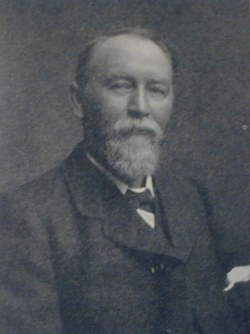 WILLIAM
YOUNG
WILLIAM
YOUNGSON of the agent of the Western Bank at Catrine in Ayrshire, and grandson of the master of the foundry there, Mr. Young was born in that trig little village lying in its cup among the braes of Kyle, on 11th September, 1845. On the collapse of the Western Bank in 1857 his father transferred his services to the Royal Bank in Exchange Square, Glasgow. Here the son attended, first, Free St. John's School, off Gallowgate, then in charge of the late Mr. James Craigie, LL.D., the respected Clerk of Govan School Board, and afterwards the old High School in John Street, and the commercial academy of Mr.William Leiper, father of the accomplished architect and Royal Scottish Academician of to-day. In 1862 he began commercial life, and held the situation of clerk successively in the offices of a measurer and of a ship and insurance broker. He next entered the Cowcaddens branch of the Royal Bank, and was transferred to the office in Exchange Square in 1864. Here latterly, from 1874 till 1877, he acted as a teller. For some time, however, he had devoted all his leisure to painting from nature and attending classes for instruction in the art. His teachers were J. A. Hutchison of the High School, Robert Greenlees of the School of art in Ingram Street, and A. D. Robertson of the Mechanics' Institution in Bath Street. From the last-named he also acquired the interest in archaeology, and especially the history and antiquities of Glasgow, which remains his hobby to the present hour. Mr. Young's art work deals with the glens, mountains, and lochs of Scotland - "the foaming stream, the purple-tinted hill, and the moorland road" are favourite subjects.
He was one of the original founders of the Glasgow art Club, which took inception in 1867 in the house of his friend and fellow-student, William Dennistoun, in the village of Old Kilpatrick. He is a member of the Regality Club, and has contributed to its publications papers on Kelvingrove and Govan: and he takes a keen interest in the work of the Glasgow Archaeological Society, of whose Council he is a member. He took an active part as Convener of the art Committee in organising and carrying through the Old Glasgow Exhibition of 1894, held in the galleries of the Glasgow Institute of the Fine arts; and to the memorial catalogue he contributed the article on "Views, Plans, and Maps." Two years later he was a member of the Executive Committee of the Burns' Exhibition held in the same galleries, and contributed to the memorial volume a short article on the "Portraits and Pictures." He also wrote the introduction to the volume containing an interesting series of photogravures by Messrs. Annan, entitled "The Old Closes and Streets of Glasgow," published by Messrs. MacLehose in 1900; and he has been the author of articles in the Glasgow Herald on "Early art in Glasgow," and on the pictorial contents of the Old Glasgow section of Glasgow International Exhibition of 1901. To the volume "Scottish History and Life" commemorating this exhibition, and published by Messrs. MacLehose in 1902, he contributed the article on "Memorials of Glasgow."
Next to the archaeology of old Glasgow his chief hobby is music. At one time he was a performer in the Glasgow Amateur Orchestral Society. He is an amateur photographer of some reputation, and he is an enthusiastic admirer of Burns and Carlyle. He has been for many years Honorary Treasurer of the Scottish Artists Benevolent Association.